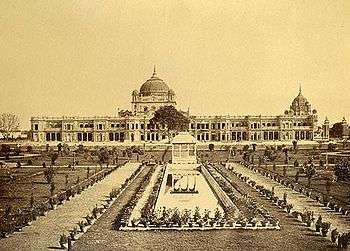Wajid Ali Shah
| Nawab Wajid Ali Shah | |||||
|---|---|---|---|---|---|
|
Mirza (Royal title) King of Oudh | |||||
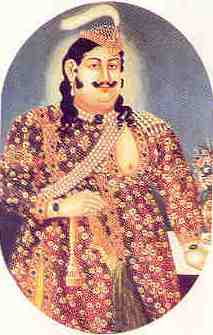 | |||||
| Reign | 13 February 1847 – 11 February 1856 | ||||
| Predecessor | Amjad Ali Shah | ||||
| Successor | Birjis Qadra | ||||
| Born |
30 July 1822 Lucknow, British India | ||||
| Died |
21 September 1887 (aged 65) Metiabruz, Garden Reach, Calcutta, British India | ||||
| |||||
| Dynasty | Awadh | ||||
| Father | Amjad Ali Shah | ||||
| Religion | Shia Islam | ||||

Wajid Ali Shah (Urdu: واجد علی شاہ) (b. 30 July 1822 – d. 1 September 1887) was the tenth and last Nawab of Awadh, holding the position for 9 years, from February 13, 1847 to February 11, 1856.[1][2]
Nawab Wajid Ali Shah's first wife Begum Hazrat Mahal, a woman who has gone down in history for her valour and courage in standing up to the might of the British forces in the revolt of 1857.[3]
His kingdom, long protected by the British under treaty, was eventually annexed bloodlessly on February 11, 1856, 2 days before the ninth anniversary of his coronation. The Nawab was exiled to Garden Reach in Metiabruz, then a suburb of Kolkata, where he lived out the rest of his life off a generous pension. He was a poet, playwright, dancer and great patron of the arts. He is widely credited with the revival of Kathak as a major form of classical Indian dance.
As a Nawab

Wajid Ali Shah succeeded to the throne of Awadh when the kingdom was well past its heyday. The British had annexed much of the kingdom under the treaty of 1801, and had impoverished Awadh by imposing a hugely expensive, British-run army and repeated demands for loans. The independence of Awadh in name was tolerated by the British only because they still needed a buffer state between their presence in the East and South, and the remnants of the Mughal Empire to the North.
Wajid Ali Shah was most unfortunate to have ascended the throne of Oudh at a time when the British East India Company was determined to grab the coveted throne of prosperous Awadh, which was "the garden, granary, and queen-province of India"- the royal predecessors and successors of Awadh were one of the major threats to the Mughal Empire before Britain's attempt at usurping full political control in India.
In different circumstances perhaps, he might have succeeded as a ruler because he had many qualities that make a good administrator. He was generous, kind and compassionate towards his subjects, besides being one of the most magnanimous and passionate patrons of fine arts in the Indian tradition. When he ascended the throne, he took keen interest in the administration of justice, introduced reforms, and reorganised the military. Wajid Ali Shah was widely regarded as a debauched and detached ruler, but some of his notoriety seems to have been misplaced. The main case for condemnation comes from the British Resident of Lucknow, General Sleeman, who submitted a report highlighting "maladministration" and " "lawlessness" he described as prevailing there. This provided the British with the facade of "benevolence" they were looking for, and formed the official basis for their annexation. Recent studies have, however, suggested that Oudh was neither as bankrupt nor as lawless as the British had claimed. In fact, Oudh was for all practical purposes under British rule well before the annexation, with the Nawab playing little more than a titular role. The army was composed mostly of British officers, while the purse strings were firmly under the control of the East India Company. In his book "Awadh Under Wajid Ali Shah", Dr. G.D. Bhatnagar[4] gives the following assessment of this ill-starred prince:
"Cast by providence for the role of an accomplished dilettante, he found himself a misfit for the high office to which he was elevated by chance. Wajid Ali Shah's character was complex. Though he was a man of pleasure, he was neither an unscrupulous knave nor a brainless libertine. He was a lovable and generous gentleman. He was a voluptuary, still he never touched wine, and though sunk in pleasure, he never missed his five daily prayers. It was the literary and artistic attainments of Wajid Ali Shah which distinguished him from his contemporaries."
Dr. G.D. Bhatnagar, Awadh Under Wajid Ali Shah
Patron of the arts

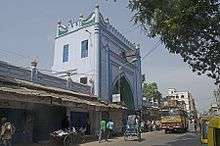
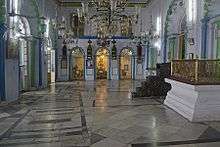
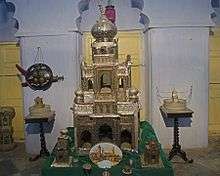
Contributions to Music
A large number of composers who thrived under the lavish patronage of the Nawab rulers of Lucknow enriched the light classical form of thumri; most prominent among these was Wajid Ali Shah. He was not only a munificent patron of music, dance, drama, and poetry, but was himself a gifted composer. He had received vocal training under great Ustads like Basit Khan, Pyar Khan and Jafar Khan. Pyar Khan, Jafar Khan and Basit Khan were the direct descendants of Mian Tansen and were the sons of the famous tanseni Chajju Khan. Bahadur Hussain Khan/Zia-ud-Daulah was the favourite musician of Wajid Ali Shah. Bahadur Hussain Khan was the son of the famous Sufi saint Jeevan Shah of Jhansi and descendant of Tansen's son-in-law Naubat Khan. Although Wajid Ali Shah's pen-name was "Qaisar", he used the pseudonym "Akhtarpiya" for his numerous compositions. Under this pen name, he wrote over forty works – poems, prose and thumris. Diwan-i-Akhtar, Husn-i-Akhtar contain his ghazals. He is said to have composed many new ragas and named them Jogi, Juhi, Shah-Pasand, etc.
The source for much information on music in Nawabi Lucknow comes from the text Ma’danul Moosiqui (‘The Mine of Music’) of Hakim Mohammed Karam Imam, courtier of Wajid Ali Shah.[5] During his time, complicated ragas like hori and dhrupad were ignored and easier raginis like tilak, pilu, sendura, khammach, bhairvi and jhanjhauti were encouraged. As these were liked by the king and easily understood by all sections of society, they came to be well-loved by commoners. Wajid Ali Shah has been accused of cheapening the classical tradition and promoting lighter forms of music such as ghazals and thumris. But then, as argued by scholars like Ravi Bhatt, this is how popular music has always been criticised.[6] Popular belief has it that the light classical form, thumri was created by Wajid Ali Shah. But James Kippen argued that, evidence suggests thumri had almost certainly already become an independent vocal form somewhat influenced by khayal by 1800, becoming extremely popular and pervasive in the time of Wajid Ali Shah. Wajid Ali wrote and performed ghazals, and the modern day style of ghazals were certainly evolved by his innovative ideas and experimentations in ghazals, some of which were noted for their inclusion of obscenities and sexually explicit references to his own private life.[7]
Contributions to Dance: Kathak
Together with music, dance in Lucknow developed strongly and became a pre-eminent art under the patronage of Wajid Ali Shah. In the ancient times Kathak being the part of the temple ritual, was performed at temples. With the change of time the Kathak performers in search of better prospects and rich patronage left the temple and entered into royal courts. Transformation was inevitable. The dance started adapting itself to the demands of the court, but it was under the artistic guidance and patronage of Nawab Wajid Ali Shah, that Kathak achieved greater dimensions. He gave a definite form, made it more artistic, and gave to it an aesthetic touch, he enriched it with rasa and bhava, and he added literature to it, lent it sensuality, and furnished it with grandeur and splendor to its presentation, argued Abdul Halim Sharar.[8] During this period, Kathak was also extensively performed by tawaifs, who themselves developed the art in parallel to its refinement in court. They frequently performed on lighter classical music of such as dadra, kajri and tappa as well as thumri. Given the tawaifs' environment, their performance style of Kathak also differed from the court style, involving more of what in Kathak is termed nakhra (mischievous playfulness).[9]
Wajid Ali Shah started two distinct forms one is Rahas and the other one is called Raas. He himself choreographed a dance based on the moves of Kathak called, Rahas, that he danced himself with the ladies of his court. For him Rahas was a dramatic form of theatre including acting, dancing, and music and with different scenes the whole setting and locale changes. On the other hand Raas was purely a religious form. Primarily Dhrupad was sung in Raas and the performance began with its singing. Raas was a circular form of dance where many gopis danced with one Krishna. Radhakamal Mukerjee in his book, The Lord of the Autumn Moons, says that the Raspancadhyayi or the five chapters pertaining to the circular group dance of Krishna with the Gopis, distill the embody the fully maturity of the mystical emotions.[10]
Kathak dance attained new heights of popularity and glory under his expert guidance and lavish patronage. Thakur Prasadji was his Kathak guru, and the unforgettable Kalka-Binda brothers performed in his court. What with the grand pageantry of the Rahas, Jogiya Jashan, Dance dramas, and Kathak performances, Lucknow became the magnetic cultural centre where the most reputed musicians, dancers and poets of the time flourished. The greatest musicians, dancers and instrumentalists of the time enjoyed his munificent patronage and hospitality. It was at his reign that Lucknow Gharana came into existence. It was in this period that the Lucknow Gharana of Kathak attained maturity, through the efforts of the stalwarts like Thakur Prasadji and others. The Lucknow style of Kathak dance is characterized by graceful movements, elegance and natural poise with dance. Abhinaya, concern for movement shape and creative improvisations are the hallmarks of this style. He not only made Kathak as the official court dance, but using it in performances of rahas made it popular among the people.
Contributions to Hindustani Theatre
When Wajid Ali Shah was a young boy, some astrologers warned his parents that he would become a Yogi, and advised them that the boy should be dressed up as a Yogi on each birthday of his so as to counteract the effect of the evil stars. He established his famous Parikhaana (abode of fairies) in which hundreds of beautiful and talented girls were taught music and dancing by expert-teachers engaged by the royal patron. These girls were known as Paris (fairies) with names such as Sultan pari, Mahrukh pari and so on. On each birthday, the Nawab would dress up as a Yogi with saffron robes, ash of pearls smeared on his face and body, necklaces of pearls around his neck, and a rosary in his hand, and walk pompously into the court with two of his 'paris dressed up as Jogans. Gradually he made it into a spectacular pageant or Mela known as Jogia Jashan, in which all citizens of Lucknow could participate, dressed as Yogis, irrespective of caste and creed. Later on, when his favourite venue, the Qaisarbagh Baradari was built, he began to stage his magnificent Rahas (obviously a Persianised name for Rasleela) full of sensuous poetry, his own lyrical compositions and glamorous Kathak dances.
Ranbir Singh gives details of Wajid Ali Shah's book entitled Bani in which the author mentions 36 types of Rahas all set in Kathak style (with colourful names like Mor-Chchatr, Ghunghat, Salami, Mor Pankhi and Mujra), and gives exhaustive notes about the costumes, jewellery, and stage- craft. Rahas, prepared at a fabulous cost of several lakhs (hundred thousands) of rupees, became very popular, and was performed at the Kaisarbagh-Rahas Manzil, (most probably the first Hindustani Theatre Hall). Many have regarded Wajid Ali Shah as "the first playwright of the Hindustani theatre", because his "Radha Kanhaiyya Ka Qissa" staged in the Rahas Manzil was the first play of its kind. It featured the Goddess Radha, Lord Krishna, several sakhis, and a Vidushaka-like character named "Ramchera". Songs, dances, mime, and drama were all delightfully synthesised in these Rahas performances. He dramatised many other poems such as Darya-i-Tashsq, Afsane-i-Isbaq, and Bhahar-i-Ulfat. It is said that Amanat's Inder Sabha was inspired by these dance-dramas, written, produced and staged by Nawab Wajid Ali Shah.
Contributions to Literature
Like the Performing Arts Wajid Ali Shah also patronised literature and several poets and writers in his court. Notable among them were ‘Barq’, ‘Ahmad Mirza Sabir’, ‘Mufti Munshi’, and ‘Aamir Ahmad Amir’, who wrote books at the orders of Wajid Ali Shah, Irshad-us-Sultan and Hidayat-us-Sultan, Amanat the famous author of Indra Sabha and Bekhud wrote Jalwa-Akhatar, Hajjo Sharaf and Afsana-i-Lucknow have presented a picture of the times and life of Wajid Ali Shah. The famous poet Ghalib also received the gracious patronage of Wajid Ali Shah, who granted him a pension of Rupees five hundred per year in 1854.[11] Wajid Ali Shah used to write himself and was a poet of a considerable merit. He used to write under the nom-de-plume of ‘Akhtar’. He had equal command over Persian and Urdu and wrote several books in both languages. According to his court chronicler Masih-ud-Din he received a liberal western education and was well versed in ancient and modern history and literature. Garcin de Tassy, while travelling in the sub-continent during the mid-nineteenth century wrote in his journal about Wajid Ali Shah and noted that, “I do not have to appreciate here this very political resolution, neither do I have to appreciate the qualities or defects of Wajid Ali Shah, as a sovereign, but I am interested in him as a distinguished scholar and as eminent poet in Hindustani”.[12]
Wajid Ali Shah wrote extensively and adopted a simple language which easily conveyed meaning to all, it showed sprinkling of Awadhi, the local dialect. He was a prolific writer. His work Sawat-ul-Qalub runs into 1061 pages and comprises a collection of 44,562 couplets, and was completed in a short span of three years. Abdul Lais Siddiqi in Lucknow Ka Dabistan-i-Shairi noted that, it was common for kings to employ poets to write on their behalf but this was not true of Wajid Ali Shah, and every single word has been written by himself and no one else.[13] One of his most important works is the autobiographical Huzn-i-Akhtar, which is in verse and contains nearly 1276 couplets. It is faithful records of the hazardous journey that he undertook from Lucknow to Calcutta, after having relinquished his crown. It speaks of the unkind and unceremonious treatment metted to him by the British authorities. Vivid details of the people and the places he encountered on his journey. It also evokes his desperation at his arrest and subsequent deportment to Calcutta’s Matiya Burj. Another important work of his is Bani which runs into 400 pages. It is a treatise on Music and Dance, which offers details of the mushairas held at Matiya Burj, of the buildings raised there at his command. There are also descriptions of the animals at his personal zoo, besides vignettes of the life and the time at Matiya Burj. Although it is estimated that he wrote over 60 books but most of his works are not available and hence no critical assessment of his writing has been made till date.[14]
His exile years
After losing the kingdom, the Nawab first went to Kanpur and then progressed to Calcutta in a steamer accompanied by his close relatives and large entourage comprising musicians, nautch girls, cooks and animals from his menagerie and came ashore at Bichali Ghat near Metiabruz, Calcutta on 13 May 1856.[15] He had made up his mind to go and plead his case to Queen Victoria because of his firm belief in the British sense of justice. However, his physicians did not think his health would permit such a long voyage and it was his mother, brother and heir apparent who left for England. A year later when the First War of Independence spread to Lucknow and the sepoys installed one of his sons to the throne of Awadh, Wajid Ali Shah was imprisoned in Fort William by the British along with his Prime Minister, due to apprehensions that he would become a rallying figure for the sepoys. HEA Cotton wrote that on Panic Sunday (14 June 1857), there was wide spread apprehension among the white inhabitants of Kolkata because he had "one, two, three thousand" (no one knew) armed men under him. The First War of Independence dashed all his hopes of returning to Lucknow.[16] After his release from Fort William, he was "allotted" a building called BNR House in Garden Reach near the headquarter of South Eastern Railway, Kolkata. In those days, it is said, it was called Parikhana.[17] However, heartbroken after leaving Lucknow, he had carried his dear city in his heart and proceeded to carve out a miniature of Lucknow in Metiabruz. In his exile in Metiabruz, he tried to keep the sweet memories of his Lucknow era alive by recreating the musical environments of his Kaisarbagh Baradari. The banished king had been "given" a number of fine houses with vast grounds stretching along the banks of the river Hooghly three to four miles south of Kolkata. Because of the presence there of an earthen dome (or raised platform), people would refer to it as Matiya Burj. The king spent lavishly out of his income of 12 lakhs (or, 1.2 million) rupees per annum and before long a "second Lucknow" arose in this area.[18]
His legacy: "Babul Mora" Thumri
His bhairavi thumri Babul Mora Naihar Chhooto Jaay has been sung by several prominent singers, but a particularly popular rendition remembered today was performed by Kundan Lal Saigal for the 1930s movie Street Singer.
In a strange manner, this sad song epitomises the pain and agony of the poet king himself when he was exiled from his beloved Lucknow.
Devanagari Lyrics
बाबुल मोरा, नैहर छूटो ही जाए
बाबुल मोरा, नैहर छूटो ही जाए
चार कहार मिल, मोरी डोलिया सजावें (उठायें)
मोरा अपना बेगाना छूटो जाए | बाबुल मोरा ...
आँगना तो पर्बत भयो और देहरी भयी बिदेश
जाए बाबुल घर आपनो मैं चली पीया के देश | बाबुल मोरा ...
Urdu Lyrics
بابُل مورا، نیہر چھُوٹو ہی جائے
بابُل مورا، نیہر چھُوٹو ہی جائے
چار کہار مِل، موری ڈولِیا سجاویں (اُٹھایّں)
مورا اَپنا بیگانا چھُوٹو جائے ، بابُل مورا۔۔۔
آںگنا تو پربت بھیو اؤر دیہری بھیی بِدیش
جائے بابُل گھر آپنو میں چلی پیّا کے دیش ، بابُل مورا ۔۔۔
- The thumri refers to his exile. For a translation see Babul.
In popular culture
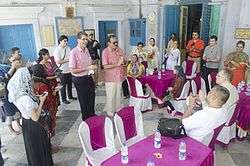
- In Satyajit Ray's Shatranj Ke Khilari, Wajid Ali Shah is shown as a very enthusiastic patron of dance and music. He is proud of the fact that songs and poems composed by him are favored by his subjects. When it is revealed that the British are about to annex his throne, his chief-minister breaks down, but he himself maintains his calm because, according to him only music and poetry can bring a real man to tears ( सिर्फ शायरी और म़ौज़िकी ही मर्द की आँख़ो में आँस़ू ला सकते हैं ). The role was played by Amjad Khan.
- On 23 May 2015 ITC Sonar organized a walk in Metibruz area as part of their Royal Kitchen series. The tour was aimed at exploring the legacies of Wajid Ali Shah in Garden Reach and Metiabruz area. The tour covered the General Manager Bungalow of South Eastern Railway, where Wajid Ali Shah once stayed and the Sibtainbad Imambara where he was laid to rest. The tour participants also visited the Bichali Ghat, where Wajid Ali Shah first landed after his deportation from Lucknow.[19]
Timeline
| Preceded by Naser ad-Dowla Amjad `Ali Thorayya Jah Shah |
Padshah-e-Oudh, Shah-e Zaman 13 Feb 1847 – 7 Feb 1856 |
Succeeded by Berjis Qadr (in rebellion) |
References
- ↑ "Wajid- Ali-Shah (1847-1856)". National Informatics Centre, India. Retrieved 7 February 2013.
- ↑ "Wajid Ali Shah (1847-1856)". Lucknow.me. Retrieved 7 February 2013.
- ↑ Safvi, Rana (2016-04-07). "The Forgotten Women of 1857". The Wire. Retrieved 2016-06-19.
- ↑ "Awadh Under Wajid Ali Shah", Dr. G.D. Bhatnagar
- ↑ Graff, Violette (2010). "The Musical Evolution of Lucknow". Lucknow: Memories of a City. New Delhi: Oxford University Press. pp. 181–182.
- ↑ Bhatt, Ravi (2006). The Life and Times of the Nawabs of Lucknow. New Delhi: Rupa Publications India Pvt. Ltd. pp. 78–79.
- ↑ Graff, Violette (2010). "The Musical Evolution of Lucknow". Lucknow: Memories of a City. New Delhi: Oxford University Press. pp. 187–188.
- ↑ Sharar, Abdul Halim (1994). Lucknow: The Last Phase of an Oriental Culture. New Delhi: Oxford University Press. pp. 141–142.
- ↑ "THE LAST SONG OF AWADH - Indian Express". archive.indianexpress.com. Retrieved 2016-09-24.
- ↑ Mukerjee, Radhakamal (1957). The Lord of the Autumn Moons. Asia Publishing House. p. 99.
- ↑ Sinh, Ranbir (2002). Wajid Ali Shah: The Tragic King. Jaipur: Publication Scheme. p. 144.
- ↑ Tassy, Garcin de (1997). Muslim Festivals in India and Other Essays. New Delhi: Oxford University Press.
- ↑ Siddiqi, Abdul Lais. Lucknow Ka Dabistan-i-Shairi. New Delhi: Adabi Duniya.
- ↑ "The Cultural and Literary Contribution of Nawab Wajid Ali Shah". International Journal of English Language: Literature and Humanities. II.
- ↑ Mirza, Shahanshah (14 January 2014). "A nawab's legacy hangs by a thread". The Telegraph. Retrieved 21 April 2016.
- ↑ http://www.kolkataonwheels.com/article-details/nabab-wajid-ali-shah.html
- ↑ Das, Soumitra (22 March 2009). "River Retreats". The Telegraph. Retrieved 21 April 2016.
- ↑ http://www.kolkataonwheels.com/article-details/nabab-wajid-ali-shah.html
- ↑ Sinha, Rumela (7 May 2016). "A Saturday morning through the winding lanes of Wajid Ali Shah's Metiaburj" (t2). The Telegraph. Retrieved 18 May 2016.
External links
| Wikimedia Commons has media related to Wajid Ali Shah. |
- Royal line of Nawabs of Oudh, A complete genealogy of the rulers of Awadh
- National Informatics Centre, Lucknow – Rulers of Awadh
- NAWABS OF OUDH & THEIR SECULARISM – Dr. B. S. Saxena
- Annexation of Oudh – Its Affairs – The Truth An Extract from King Wajid Ali Shah of Awadh By Mirza Ali Azhar
- The Literary And Cultural Contributions of Wajid Ali Shah
- HISTORY OF AWADH (Oudh) a princely State of India by Hameed Akhtar Siddiqui
- My Wajid Ali is Not 'Effete And Effeminate'! -Satyajit Ray
- SWANSONG OF A POET-KING, THE STATESMAN MONDAY 5TH JULY, 1982 Calcutta – India
- Wajid Ali Shah, King of Oudh
- A tribute to Wajid Ali Shah, the last and greatest King of Avadh, THE TAJ MAGAZINE – Volume 23 No. 1
- Much of the content here has been extracted from an article by Susheela Mishra.
- "Awadh Under Wajid Ali Shah", Dr. G.D. Bhatnagar
- "Wajid Ali Shah: The Tragic King", Ranbir Sinh
- Baabul Moraa
- {nopr.niscair.res.in/bitstream/123456789/24735/1/SR%2050(12)%2028-29.pdf}Wajid Ali Shah :The Naturalist King by Shakunt Pandey
